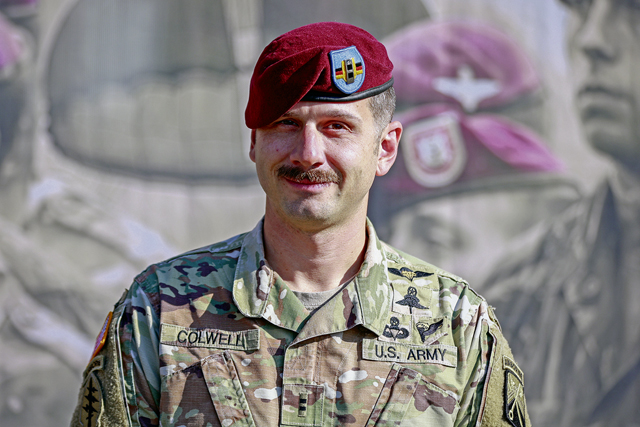
According to historians, several key factors, including inclement weather and ill-placed drop zones, threatened the Allied forces’ success during the 1944 Operation Market Garden Airborne mission to re-take control of Nazi-controlled Netherlands.
Eighty years later, when Chief Warrant Officer 2 Dustin Colwell, the support operations and transportation senior airdrop systems technician and master jumpmaster for the 16th Sustainment Brigade, arrived in Arnhem, Netherlands, at the beginning of the annual exercise combo of Falcon Leap 24 and Operation Market Garden 80 from Sept. 9-21, little did he know the success of the entire event rested on the shoulders of his expertise.
According to Colwell, U.S. aircraft were not used in the Falcon Leap or Market Garden airborne exercises in 2023. During that time, several of the drop zones’ certifications expired. Due to U.S. Air Force and Army regulations, paratroopers or cargo cannot be dropped from aircraft until a survey is created for each drop zone and signed off by a U.S. Air Force Major Command (USAFE). Drop zones must be recertified every five years or if a drop zone dimension or obstacles change in any way.
“U.S. aircraft require a U.S. drop zone survey where all the others just require a NATO survey. In order for a drop zone to be certified, a survey has to be done by qualified personnel. I went to each drop zone that needed a survey and completed it,” said Colwell.
This year’s exercise plans called for U.S. Air Force C-130 cargo aircraft to play a heavy role in both cargo and paratrooper drop/jump missions. As Army operations and Air Force aircrew personnel arrived at Arnhem’s Oranje Kazerne and realized the issue with the expired drop zone surveys, Colwell immediately jumped to action.
“Typically, once a survey is completed, it takes a couple of weeks to route through the bureaucracy,” said Colwell. “I was lucky that I already had the dimensions of almost all of the drop zones from previous surveys on file. The surveys were routed and approved within 72 hours, which is very fast. These surveys are important for the safety of the aircraft and aircrew, paratroopers and structures or people on the ground near the drop zone,” said Colwell.
Colwell and his team prioritized the survey requirements of the drop zones and physically drove to six drop zones to conduct new surveys. He then stayed up late into the night and filled out the required paperwork.
“Exercise Falcon Leap is invaluable for the bonding between NATO units and the skill of airborne units. CW2 Colwell raced through the Netherlands to make sure everything around the drop zone was in order. His contribution to the exercise was indispensable,” said Dutch Army Lt. Sjors Pajimans, the departure operations airfield officer in charge for the 11th Air Manoeuvre Brigade, Netherlands.
The main purpose of the airborne exercises is to implement proven techniques for airborne operations into action. According to Colwell, when plans go into action, it causes friction points that require motivated and knowledgeable personnel to smooth them out.
“Of course, this exercise helps us test interoperability capabilities with our NATO partners, but it also exposes gaps in capabilities as well. That is an important part of any exercise. You need those friction points. If everything goes smooth, how do you know what can be improved down the road,” said Colwell.
Provided that the drop zone dimension and locations for future Falcon Leap and Operation Market Garden exercises stay the same, Colwell’s actions have potentially certified the drop zones for the next five years.
Exercise Falcon Leap and Operation Market Garden’s annual airborne exercises are considered the stepping stones in planning for the larger annual NATO airborne exercise named “Swift Response.”


